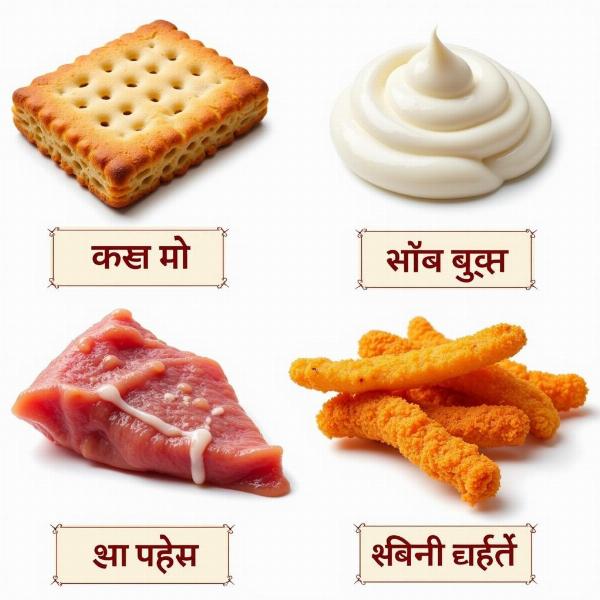Understanding the Hindi meaning of “texture” can be tricky, especially given the nuances of both Hindi and English. This guide aims to clarify the meaning of “texture” in Hindi, exploring its various applications and providing practical examples. We’ll also delve into related terms and cultural contexts to give you a comprehensive understanding of this multifaceted word.
What Does “Texture” Mean in Hindi?
“Texture” primarily refers to the surface quality of something, how it feels to the touch. In Hindi, there isn’t one single perfect equivalent, but several words can convey the meaning depending on the context. Common translations include “रचना” (rachna), meaning structure or composition, “बनावट” (banawat), referring to formation or build, and “गुणवत्ता” (gunvatta), which translates to quality. Sometimes, “स्पर्श” (sparsh), meaning touch, can also be used when emphasizing the tactile aspect.
Exploring the Different Hindi Translations of “Texture”
Each Hindi word offers a slightly different perspective on the concept of texture. “रचना” (rachna) focuses on the arrangement of elements that create the texture, while “बनावट” (banawat) emphasizes the way something is made or formed. “गुणवत्ता” (gunvatta) highlights the overall quality, which can include texture as a contributing factor. Choosing the right word depends on what aspect of texture you want to emphasize.
Texture in Different Contexts: Food, Fabrics, and More
The Hindi word you choose for “texture” can vary depending on what you’re describing. For instance, when talking about the texture of food, you might use “बनावट” (banawat) to describe the consistency, like “मुलायम बनावट” (mulayam banawat) for a soft texture or “खुरदुरी बनावट” (khurduri banawat) for a rough texture. For fabrics, “रचना” (rachna) might be more appropriate, such as “महीन रचना” (mahin rachna) for a fine texture.
 Hindi Meaning of Food Texture
Hindi Meaning of Food Texture
Texture in Art and Design: A Cultural Perspective
In Indian art and design, texture plays a significant role. From the intricate carvings on temple walls to the delicate embroidery on traditional garments, texture adds depth and richness to artistic expression. Understanding the cultural significance of texture can help you appreciate the nuances of Hindi words related to this concept.
How to Use “Texture” in a Hindi Sentence
Here are some examples of how to use Hindi words for “texture” in sentences:
- “इस कपड़े की बनावट बहुत मुलायम है” (Is kapde ki banawat bahut mulayam hai) – The texture of this cloth is very soft.
- “खाने की रचना बहुत अच्छी थी” (Khane ki rachna bahut achhi thi) – The texture of the food was very good.
Beyond the Basics: Exploring Related Terms
Beyond the core translations, several related Hindi words can further refine the meaning of “texture.” For example, “घनत्व” (ghantv) refers to density, which is closely related to texture. Similarly, “मोटाई” (motai) denotes thickness, another aspect that contributes to the overall tactile experience.
Conclusion: Mastering the Meaning of “Texture” in Hindi
Understanding “texture ka hindi meaning” requires appreciating the subtle differences between various Hindi words and their contextual usage. By considering the specific application and cultural nuances, you can effectively communicate the concept of texture in Hindi. This guide has provided you with a solid foundation for understanding and using these terms.
FAQ
- What is the most common Hindi word for “texture”? While there isn’t one single word, “बनावट” (banawat) and “रचना” (rachna) are frequently used.
- How do I choose the right Hindi word for “texture”? Consider the context. For food, “बनावट” is often suitable. For fabrics or artistic contexts, “रचना” might be more appropriate.
- Does “गुणवत्ता” (gunvatta) mean exactly “texture”? No, it means “quality,” which can encompass texture as one of its aspects.
- Are there other Hindi words related to “texture”? Yes, words like “घनत्व” (density) and “मोटाई” (thickness) are related.
- Is understanding the cultural context important when talking about texture in Hindi? Yes, appreciating the role of texture in Indian art and culture enhances your understanding of the nuanced meanings.
Related Articles
- fruit pulp meaning in hindi
- hydrogenation meaning in hindi
- farsan flour meaning in hindi
- offal meaning in hindi
Meaning-Hindi.in offers professional translation services for businesses, legal documents, technical manuals, websites, and educational materials. We specialize in Hindi translation and localization, ensuring accurate and culturally sensitive communication. Whether you need quick translation or specialized expertise, our team delivers high-quality results. Contact us for your translation needs at [email protected] or +91 11-4502-7584. Meaning-Hindi.in is your trusted partner for bridging language barriers.